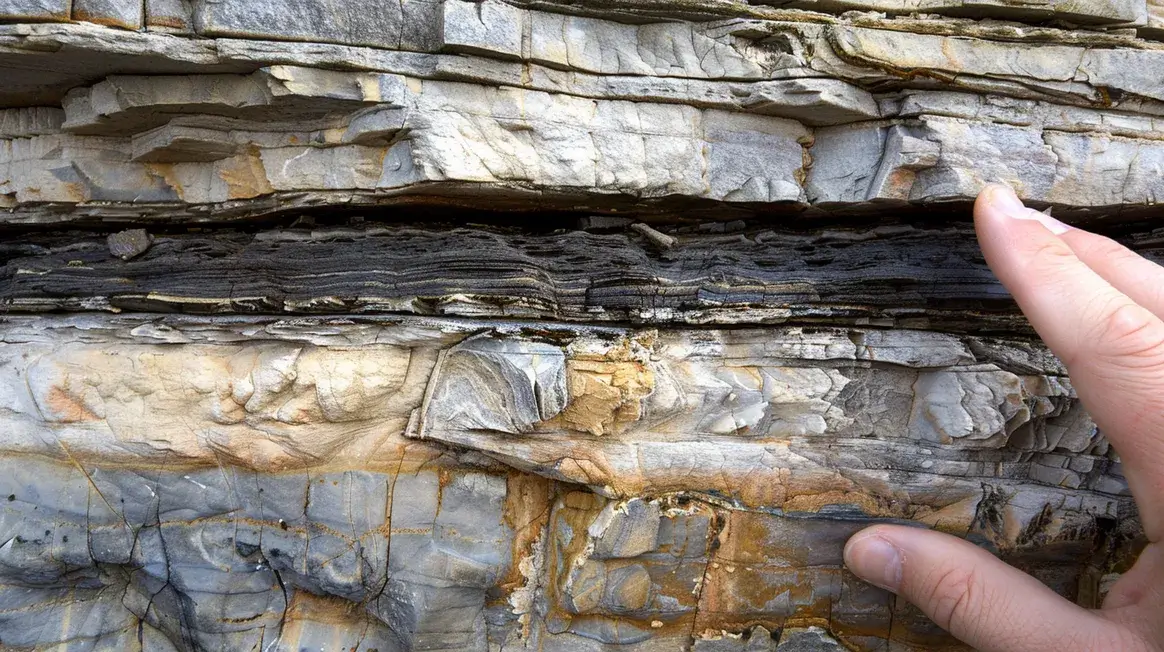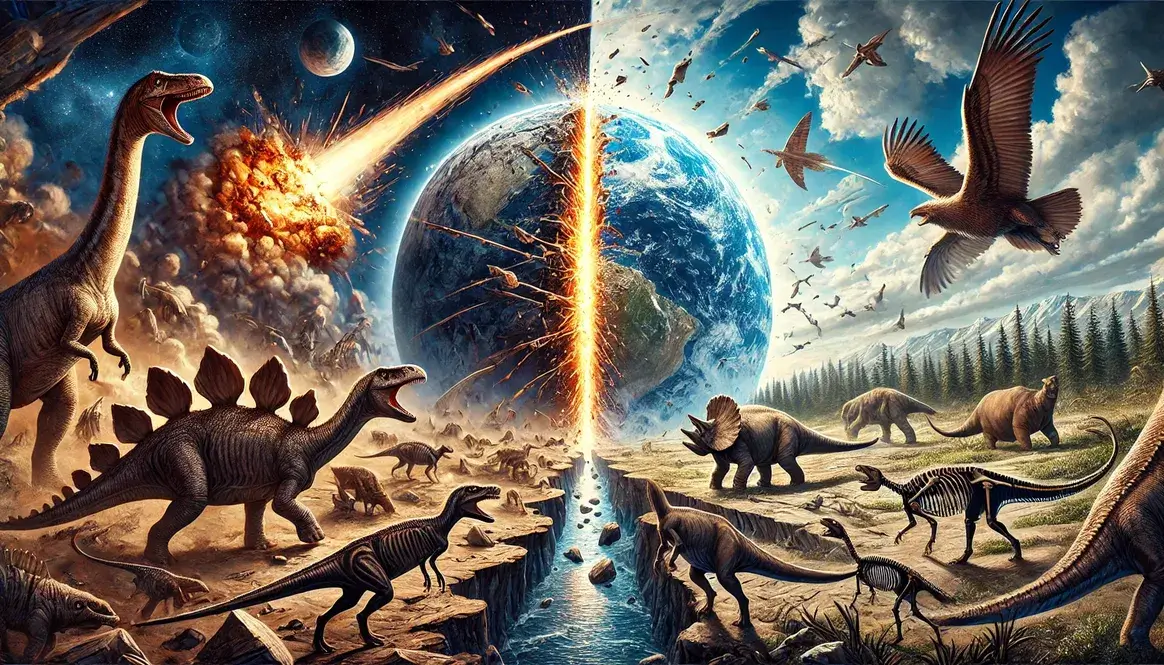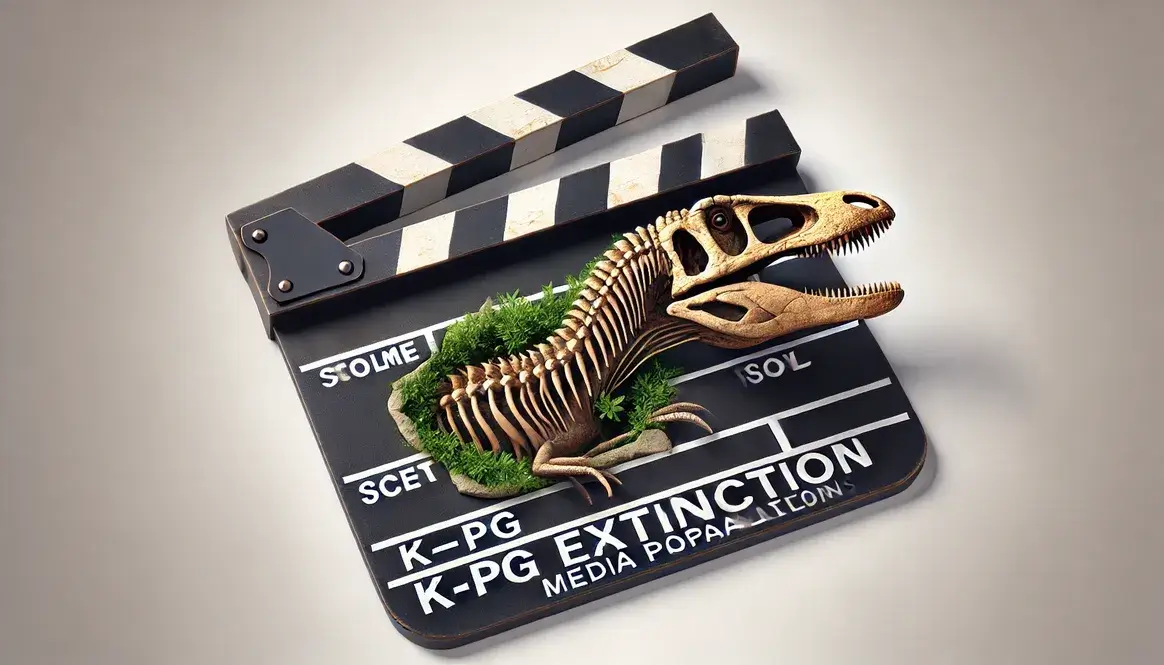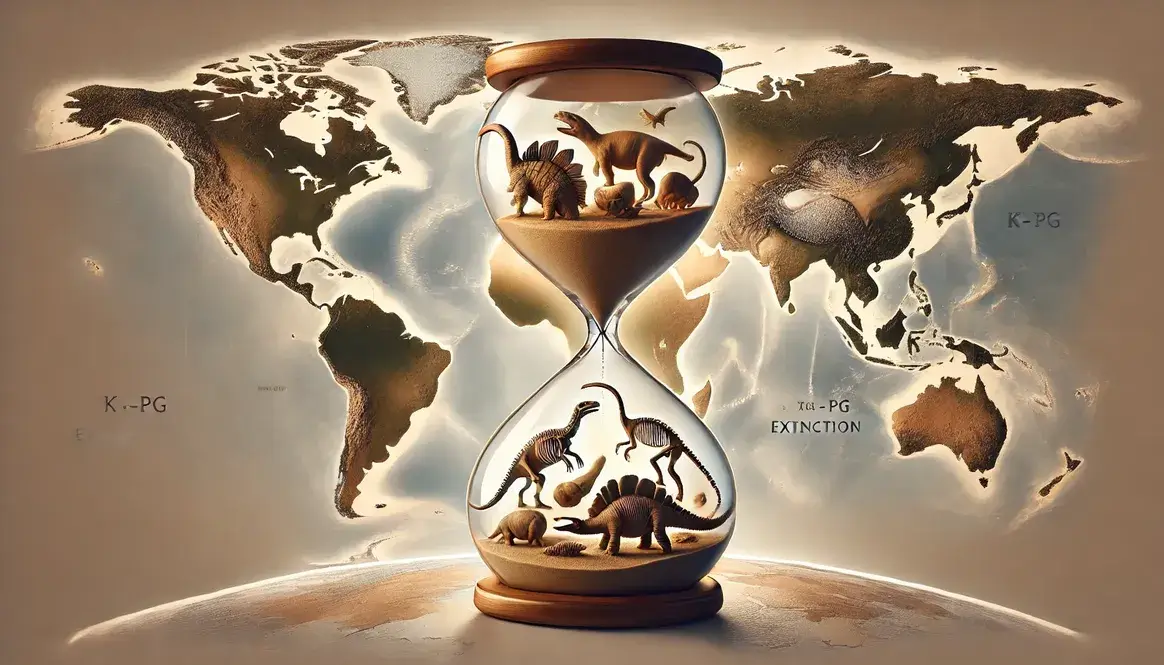The K-Pg boundary is a thin layer of rock that marks one of the most significant moments in Earth’s history. It’s the dividing line between two major time periods: the Cretaceous and the Paleogene. This boundary represents a turning point in our planet’s story, separating the age of dinosaurs from the rise of mammals.
The K-Pg boundary defined
So what is the K-Pg boundary exactly? The K-Pg boundary is a distinct layer of sediment found in rock formations around the world. It’s like a page in Earth’s history book that tells us about a major event that happened about 66 million years ago. This thin line in the rocks shows us when the Cretaceous period ended and the Paleogene period began.
But why is it called the “K-Pg” boundary? The “K” stands for Cretaceous (scientists use “K” because “C” was already taken for another period), and “Pg” is short for Paleogene. Before 2008, people called it the K-T boundary, with “T” standing for Tertiary. Scientists changed the name to be more accurate, but you might still see “K-T” in older books or articles.
This boundary is super important because it marks a time when life on Earth changed dramatically. Many animals and plants that were common during the Cretaceous period, including the dinosaurs, suddenly disappeared. It’s like nature pressed a giant reset button, paving the way for new forms of life to take over.
The K-Pg boundary isn’t just a line in the rocks – it’s a window into one of the most fascinating chapters in Earth’s long history. It helps scientists understand how life can change rapidly and how our planet has evolved over millions of years.
Characteristics of the K-Pg boundary layer
The K-Pg boundary layer is like a thin bookmark in Earth’s rock library. It’s got some unique features that make it stand out from the layers above and below it. Let’s take a closer look at what makes this layer so special.
Physical appearance
When scientists dig into rocks from around the time of the K-Pg boundary, they often find a thin layer of clay that looks different from the surrounding rock. This clay layer is usually:
- Dark in color, often appearing as a rusty red or dark grey
- Very fine-grained, feeling smooth to the touch
- Distinctly different from the rocks above and below it
The thickness of this layer can vary quite a bit depending on where you find it. In some places, it might be as thin as a pencil lead, while in others, it could be as thick as your thumb. For example:
| Location | Thickness |
|---|---|
| Denmark | 1-2 cm |
| Italy | 2-3 cm |
| New Zealand | Up to 12 cm |
These differences in thickness can tell scientists a lot about how the K-Pg extinction event affected different parts of the world.
Chemical composition
The K-Pg boundary layer isn’t just special because of how it looks – it’s also unique in what it’s made of. Scientists have found some interesting stuff in this layer that you don’t normally see in other rocks.
One of the most important things they’ve found is a metal called iridium. Iridium is pretty rare on Earth’s surface, but there’s a whole lot of it in this boundary layer. This discovery was a big clue that helped scientists figure out what might have caused the mass extinction at the end of the Cretaceous period.
But iridium isn’t the only odd thing in this layer. Scientists have also found:
- Shocked quartz: These are quartz crystals that show signs of intense pressure, like what you’d get from a massive impact.
- Tiny glass beads called tektites: These form when rock is melted and then quickly cooled, like what happens during a meteor impact.
- Soot and charcoal: These suggest widespread fires happened around the same time.
All these unusual materials paint a picture of a catastrophic event that dramatically changed Earth’s surface and atmosphere. This evidence has led many scientists to conclude that a large asteroid impact played a key role in the changes that occurred at the K-Pg boundary.
Geological evidence at the K-Pg boundary
The K-Pg boundary isn’t just a line in the rocks – it’s a treasure trove of clues that help us understand what happened during one of Earth’s most dramatic moments. Let’s dig into some of the most compelling evidence found at this boundary.
Iridium anomaly
In 1980, a team of scientists led by Luis and Walter Alvarez made a groundbreaking discovery. They found unusually high levels of iridium in the K-Pg boundary clay. This finding, known as the iridium anomaly, sparked a scientific revolution.
Why is iridium so important?
- Rarity on Earth: Iridium is extremely rare in Earth’s crust.
- Abundance in space: It’s much more common in asteroids and comets.
- Concentration: The levels found at the K-Pg boundary were 30 times higher than normal.
This iridium spike suggested something extraordinary – a massive asteroid impact coinciding with the end-Cretaceous extinction. It was a crucial piece of evidence linking cosmic events to Earth’s mass extinctions.
Impact-related materials
The iridium anomaly was just the beginning. As scientists continued to study the K-Pg boundary, they found more evidence supporting the impact theory.
Tektites and spherules: These are tiny glass beads formed when rock melts and cools rapidly. At the K-Pg boundary, scientists found layers of these objects, some as small as grains of sand. Their presence suggests that a massive amount of rock was melted and ejected into the atmosphere, raining back down as these glassy particles.
| Material | Size | Formation |
|---|---|---|
| Tektites | 1mm – several cm | Formed from terrestrial rock melted by impact |
| Spherules | Microscopic – 1mm | Condensed from vaporized rock |
Nickel-rich spinels: These are microscopic crystals rich in nickel and other metals. They’re particularly interesting because they form under very specific conditions – conditions that match what we’d expect from a large asteroid impact. The presence of these spinels adds another layer of evidence to the impact theory.
All these materials tell a story of a cataclysmic event that dramatically altered Earth’s surface. They support the idea that a massive asteroid strike played a key role in the events surrounding the K-Pg boundary, contributing to the extinction of dinosaurs and many other species.
This geological evidence, combined with the discovery of the Chicxulub crater in Mexico, has built a compelling case for the asteroid impact theory. It’s a fascinating example of how tiny clues can help us unravel huge events in Earth’s history.
Global distribution of the K-Pg boundary
The K-Pg boundary isn’t confined to one spot on Earth – it’s a global phenomenon. Scientists have found evidence of this boundary layer on every continent, painting a picture of a truly world-changing event. Let’s explore where we can find these traces of Earth’s turbulent past and how they differ around the globe.
Key locations
K-Pg boundary sites are scattered across the world, each telling its own part of the extinction story. Here are some notable locations:
- Gubbio, Italy: One of the first places where the iridium anomaly was discovered.
- Hell Creek, Montana, USA: Famous for its well-preserved dinosaur fossils and clear K-Pg boundary.
- Chicxulub, Mexico: The site of the impact crater itself.
- Stevns Klint, Denmark: A UNESCO World Heritage site with a visible K-Pg boundary.
These sites don’t all look the same, though. The boundary layer can vary quite a bit depending on where you find it. For example:
| Location | Thickness | Notable Features |
|---|---|---|
| Gubbio, Italy | 1-2 cm | High iridium content |
| Hell Creek, Montana | 1-2 cm | Contains shocked quartz |
| El Kef, Tunisia | 50-60 cm | Thick clay layer |
| Chicxulub, Mexico | Several meters | Impact breccia and melt rocks |
These variations can tell us a lot about how the K-Pg extinction effects differed around the world.
Marine vs. terrestrial boundary sites
The K-Pg boundary looks different depending on whether it formed on land or under the sea. This difference can make it tricky for scientists to piece together the full picture of what happened.
Marine sites:
- Often better preserved
- Usually contain a clear, thin clay layer
- Rich in microfossils like foraminifera
- May include tsunami deposits
Terrestrial sites:
- Generally harder to identify
- May be thicker and more variable
- Often contain coal layers or fossilized plants
- Can include evidence of wildfires (charcoal layers)
Finding and studying terrestrial K-Pg sites can be challenging. Unlike marine sites, which often have a neat, continuous layer, land-based sites can be messy. Erosion, plant growth, and other factors can disturb the boundary layer, making it harder to spot.
Despite these challenges, terrestrial sites are crucial for understanding how the K-Pg extinction affected life on land. They provide valuable information about how plants and animals in different environments responded to the catastrophic events at the end of the Cretaceous.
By studying both marine and terrestrial sites, scientists can build a more complete picture of this pivotal moment in Earth’s history. It’s like putting together a global jigsaw puzzle, with each site adding another piece to our understanding of the K-Pg boundary and the dramatic changes it represents.
Significance in stratigraphy
The K-Pg boundary isn’t just important for understanding dinosaur extinction – it’s a crucial tool in the field of stratigraphy, which is the study of rock layers. This thin line in the rocks helps scientists make sense of Earth’s history on a global scale.
Marking the Cretaceous-Paleogene transition
The K-Pg boundary serves as a chronostratigraphic marker, which is a fancy way of saying it’s a timestamp in the rocks. It’s like a global bookmark that scientists can use to pinpoint a specific moment in Earth’s history.
Role as a chronostratigraphic marker:
- Defines the end of the Cretaceous and start of the Paleogene
- Marks the boundary between the Mesozoic and Cenozoic eras
- Provides a clear reference point for studying Earth’s history
One of the coolest things about the K-Pg boundary is how it helps scientists correlate rock layers around the world. Imagine you’re reading a book, but the pages are scattered across different continents. The K-Pg boundary is like a sentence that appears on each page, helping you figure out how they all fit together.
For example, a geologist studying rocks in Montana can use the K-Pg boundary to match up their findings with those of a colleague working in Denmark. This global correlation allows scientists to piece together a comprehensive picture of what Earth was like 66 million years ago, including how the extinction event affected different parts of the world.
Implications for geological dating
The K-Pg boundary plays a crucial role in how we date rocks and fossils. Here’s how:
- Radiometric dating: The boundary often contains materials suitable for radiometric dating, like volcanic ash or impact-related minerals. These can provide precise ages for the boundary itself.
- Relative dating: Even when exact dates aren’t available, the boundary serves as a clear “before and after” marker. Fossils found below the boundary are known to be Cretaceous or older, while those above are Paleogene or younger.
- Calibrating the geological time scale: The precise dating of the K-Pg boundary helps scientists refine the entire geological time scale. It’s like setting your watch to an atomic clock – this one well-dated point helps make other dates more accurate.
This dating precision is crucial for understanding the timing of evolutionary events. For instance, it helps scientists calculate how quickly mammals diversified after the dinosaurs went extinct.
| Dating Method | Use in K-Pg Boundary Studies |
|---|---|
| Argon-Argon | Dating volcanic ash layers |
| Uranium-Lead | Dating zircon crystals in impact ejecta |
| Magnetostratigraphy | Correlating boundary sites globally |
By providing such a clear and widely recognizable marker in the rock record, the K-Pg boundary has revolutionized our understanding of Earth’s history. It’s a powerful tool that helps scientists piece together the story of life on our planet, from the reign of the dinosaurs to the rise of mammals and beyond.
Paleontological importance of the K-Pg boundary
The K-Pg boundary isn’t just a line in the rocks – it’s a time capsule that reveals a pivotal moment in life’s history on Earth. For paleontologists, this boundary is like a treasure chest filled with clues about one of the most dramatic events in our planet’s past.
Fossil record changes
When scientists examine fossils from rocks just below and above the K-Pg boundary, they see a stark contrast. It’s as if someone hit a giant reset button on life on Earth. Here’s what they observe:
- Below the boundary: A diverse array of Cretaceous life, including dinosaurs, pterosaurs, and marine reptiles.
- At the boundary: A sudden drop in diversity and abundance of fossils.
- Above the boundary: New forms of life begin to appear and thrive, especially mammals and birds.
This abrupt change in fossil assemblages is one of the most striking features of the K-Pg boundary. It’s like flipping through a photo album and suddenly seeing a completely different cast of characters.
The extinction patterns observed at the boundary are equally dramatic. Some groups, like non-avian dinosaurs, disappear completely. Others, like certain marine reptiles, vanish from the fossil record. But not everything died out – some groups, like crocodilians and turtles, managed to survive and persist into the Paleogene.
Key to understanding mass extinctions
The K-Pg boundary provides crucial insights into how mass extinctions work. It’s like a natural experiment that shows us what happens when Earth’s ecosystems face a major crisis.
Evidence at the boundary points to rapid, severe environmental changes:
- Sudden climate shifts
- Widespread wildfires
- Acid rain and ocean acidification
- Global darkness due to dust and aerosols in the atmosphere
By studying these changes, scientists can better understand how ecosystems respond to catastrophic events. The K-Pg boundary also sheds light on the recovery process after a mass extinction. It shows how life rebounds and new groups rise to prominence in the aftermath of a global catastrophe.
This knowledge isn’t just about the past – it helps us understand how modern ecosystems might respond to rapid environmental changes, making the study of the K-Pg boundary relevant to current conservation efforts.
Ongoing research and debates
Even after decades of study, the K-Pg boundary continues to spark scientific curiosity and debate. It’s an active area of research with new discoveries and theories emerging regularly.
Current areas of study include:
- Fine-tuning the timing of events at the K-Pg boundary
- Investigating regional variations in extinction patterns
- Exploring the long-term effects of the K-Pg extinction on evolution
While the asteroid impact theory is widely accepted, some controversies and unresolved questions remain. For instance:
- Role of volcanism: Some scientists argue that massive volcanic eruptions in India (the Deccan Traps) played a significant role in the extinction.
- Extinction timing: Debate continues about whether the extinction was instantaneous or occurred over thousands of years.
- Selectivity of extinction: Questions remain about why some groups survived while others perished.
These ongoing debates highlight the importance of the K-Pg boundary for future research. As new technologies and methods emerge, scientists continue to glean fresh insights from this crucial moment in Earth’s history.
The study of the K-Pg boundary remains vital for several reasons:
- It provides a model for understanding other mass extinctions in Earth’s history
- It offers insights into how life recovers after catastrophic events
- It helps us predict how modern ecosystems might respond to rapid environmental changes
As we face current environmental challenges, the lessons from the K-Pg boundary become increasingly relevant. By understanding this ancient crisis, we gain valuable knowledge that could help shape our approach to contemporary ecological issues.









